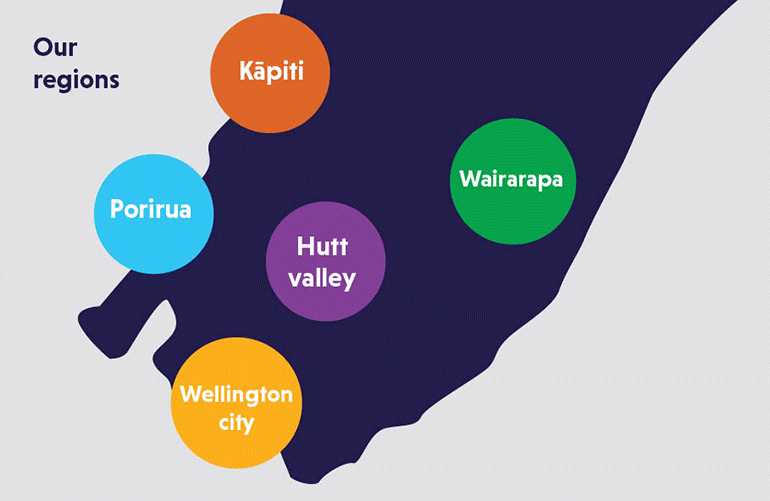About us and the Regional Workforce Plan
The Wellington Regional Skills Leadership Group (RSLG) was set up by Government as an independent advisory group to support better ways of meeting future skills and workforce needs.
On this page
Our role is to lead and influence, and make change happen regionally through coordination and collaboration. We also help the Government stay in touch with what’s happening in our region, which stretches from Wairarapa and Kāpiti in the north, to Porirua, Hutt Valley and Wellington City in the south.
We were appointed in September 2021, following on from an interim group. We’re made up of 14 permanent members including representatives of regional industry, Iwi/Māori, workers, community members, and local and central government. There are 14 other RSLGs throughout the country.
This is our first Regional Work Plan (RWP). It highlights labour supply and demand trends for the region and identifies where we can act to achieve a highly skilled and coordinated regional labour market. We don’t want to reinvent the wheel, and this plan should strengthen the work already underway in our communities.

Image description
We’ve structured the plan into two sections:
Part one: A workforce plan for region - our aspirations, our process, key challenges and what we are going to do about it
Part two: The foundations of our plan - a more detailed analysis of our region, people and sectors as well as labour market projections and our challenges
Our group will oversee the implementation of the plan, working with others in the region including in partnership with Iwi/Māori.
The plan will be refreshed annually, and we’ll update the whole plan every three years.
How we’ve approached the task
We established some principles
As a starting point, we identified guiding principles for our work:
- Actively reflecting Te Tiriti o Waitangi in our work
- Developing a highly skilled and diverse workforce
- Supporting sustainable and resilient employment
- Connecting and engaging communities
- Utilising and promoting cutting edge technology
- Demonstrating strong leadership and advocacy.
We’ve looked at the other plans within our region and nationally
There are a number of economic development local workforce and skills plans in place across our region, at various stages of implementation. We have developed our plan concurrently with the Wellington Regional Economic Development Plan and have also looked at Te Matarau a Māui, the Māori Regional Economic Development Plan. We will continue to work closely with leaders of both these plans as they are implemented.
We looked at the Wairarapa Workforce Plan (2020), the Kāpiti Coast District Workforce Plan (2022), and the Wellington Region Workforce Development Plan developed for WellingtonNZ (2019).
Wairarapa Workforce Plan 2020(external link)
Kāpiti Coast District: Workforce Plan 2022(external link)
Wellington Region Workforce Development Plan 2019(external link)
Across all the plans, we’ve tried to identify actions where the RSLG could lead or provide support and/or connection, whilst ensuring that the plan owners retain their autonomy and agency. Communities know best what they need, and what needs to be done to get there.
From these we see these common priorities:
- Optimisation of the available working population (including young people and older workers)
- Building a workforce pipeline, and alignment of education with skills needs
- Partnerships with Iwi and other key stakeholders
- Close collaboration between agencies, providers, industry and employers
- Career upskilling and reskilling, as well as entry level skill development and work readiness
- A focus on the needs of young people, especially supporting and enhancing the transition from school to employment
We’ve also looked at the government’s Employment Strategy, which seeks to address long-standing employment and training challenges and inequities for groups that consistently experience poor employment outcomes. The groups identified are older workers, Māori, Pacific peoples, disabled people, youth, women, and former refugees, recent migrants and ethnic communities. We have adopted these groups as priority communities for our plan and, as above, tried to identify where we could lead or help with actions at a regional level.
We’ve also considered Industry Transformation Plans, which have, or will have, a skills and workforce section. These are in various stages of development at present.
We’ve heard from stakeholders from across the region
In the development of this plan we’ve looked at the story behind the data.
We’ve talked to many of you from across the region including Iwi, employers, workers, unions, disabled people and Pacific peoples, former refugees and new migrants, and older workers. You have told us about the challenges that are facing employers, workers, learners and jobseekers. We’ve summarised these below, and there’s more detail in the Key Challenges section later in this plan.
< Our long-term vision for the future of Wellington region | The challenges summarised >

